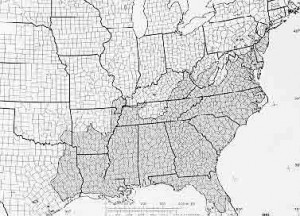The title of this blog post may be a little confusing, but it is not meant to be. (Well, maybe it is — but we’ll clear things up in a minute.)
American holly (Illex opaca) is native only to the United States but, since it closely resembled English holly to the Pilgrims, it quickly became the Americans’ symbol of Christmas. It was, and still is, found along the  coast of Massachusetts and all the way down through the southeast to East Texas. It grows in the same geographic areas as the Southern yellow pines, but since it can’t tolerate fire, it is rarely found in those pine forests that are regularly burned. So, most large trees are more commonly associated with old hardwood forests. American holly is a slow grower, taking 100 to 150 years to grow large enough for lumber, but it can grow to 70 feet tall and two feet or greater in diameter.
coast of Massachusetts and all the way down through the southeast to East Texas. It grows in the same geographic areas as the Southern yellow pines, but since it can’t tolerate fire, it is rarely found in those pine forests that are regularly burned. So, most large trees are more commonly associated with old hardwood forests. American holly is a slow grower, taking 100 to 150 years to grow large enough for lumber, but it can grow to 70 feet tall and two feet or greater in diameter.
American holly is most widely known simply as “holly” or “Christmas holly.” Its principal use is for decorating, using its leaves and twigs. It was harvested so heavily in some areas in the past that most of the trees in those places were killed. Thankfully, holly “farms” have all but replaced the harvest of wild holly foliage today. American holly is an evergreen and has beautiful curled leaves and bright red berries. The berries are distributed by cedar waxwings and other songbirds. A flock of waxwings have been observed to completely strip a full-grown holly of berries in just a few seconds. American holly is also known as “white holly,” and that is the name of most interest to woodworkers.

The wood of American holly is probably the whitest of all woods. It has an ivory white heartwood and white sapwood. The growth rings are so indistinct as to be almost invisible. Because of the rich white color of the wood, it is widely used as inlay. It provides sharp contrast to darker woods when used this way. As far as other wood properties are concerned, it is not really unique. It is relatively dense and somewhat heavy, weighing about 40 pounds per cubic foot. It is smooth textured and close grained. The wood doesn’t have an odor or taste so is well tolerated by some sensitive woodworkers.
Most importantly, American holly is rather easy to carve, turn and work. Because of its tight grain and white base color, it is a great candidate to stain. It takes almost any dye or stain very well. This property is what makes it a great candidate to mimic ebony. Since it exhibits little in the way of grain and presents a white palette with which to work, black dye will turn any piece of holly into instant “ebony.” It has been used in this way to produce piano keys, violin pegs and fingerboards. So if you have a project idea which calls for ebony and you don’t want to pay gold prices, or a very white inlay will make your project shine, try the “Christmas wood.” I think the results will please even the most discerning woodworker.
Tim Knight





